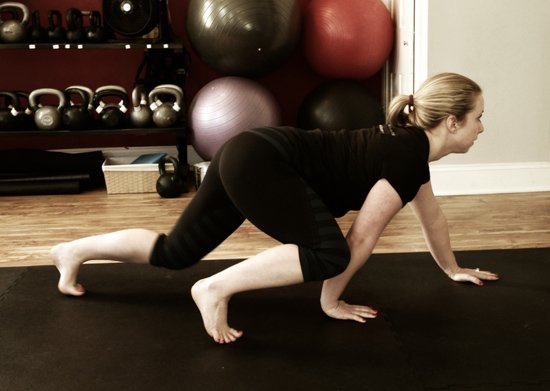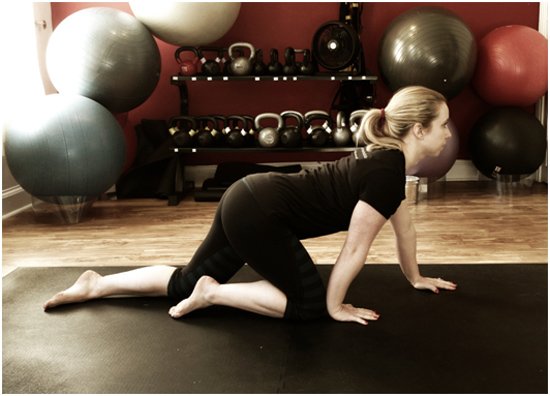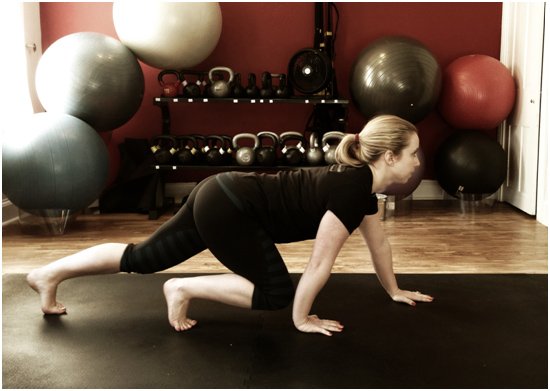By Julie Miller

There is a new way of thinking in the fitness industry. Brilliant industry minds are conducting research on how people can become stronger, faster and more functional by focusing on proper and authentic movement. With the increase of high intensity interval training (HIIT) classes and box gyms, average people are being exposed to new movements that their bodies might not be ready to perform.
Learning how to lift a weight fast can be fun, but are you doing it correctly? Can you extend both arms overhead to full lockout without lumbar spine extension? Can you squat below 90 degrees without your knees caving in or your upper body falling forward? If you can say “no” to any of those questions you may want to take a step back and slow down. Maybe it’s time to relearn those natural movement patterns and get down to basic, simple movement.
It seems silly, a little childish even, to get down on all fours and crawl around like a baby. But did you know that crawling has been linked to helping adults restore and recreate their natural movement? “Crawling is perhaps the most simple movement we can do that teaches our body how to coordinate our limbs, our reflexes, our brain hemispheres, our hand-eye coordination, our hearing, our cardio-vascular system and our muscular system. It integrates everything about us; all of us; it makes us whole,” Tim Anderson, co-author of “The Original Strength Training System,” said in a November post.
As with all new training programs, you can’t start with the most advanced movement. You have to start from the beginning. Get down on the floor on all fours and start to Baby Crawl. There are only two rules for any crawl: head up with eyes straight and keep your chest high and proud. As you get comfortable try coordinating your limbs so the opposite hand and knee contact each other as they touch the ground.

Once you feel successful with the Baby Crawl, try progressing to the Leopard Crawl. The same rules apply, but this time lift your knees a few inches off the ground. Contralateral limbs work simultaneously. As you bring your right knee forward aim for just inside your right elbow and the same for the left side. Keep your chest high, butt low and hips steady. Try to reduce the amount of noise you make when you place your hands and feet on the ground. Crawl at different speeds. If you can decrease the amount of time all four limbs are touching the floor, the more your core stabilizers will be tested.

After the Leopard Crawl, is the Spiderman Crawl. Picture a stealth and smooth Spiderman scaling buildings as you crawl around on the ground. Just like before, the chest is high, butt is low, and your eyes are looking straight in front of you, not down at the ground. Instead of the knees touching the inside of your elbows, your knees are going outside of the elbows. Experiment with your speed and be as soft as possible on your hand and foot placement.

Now that you know the three crawls, how do you add this to your training program? You can use it as part of your warm up, during your workout to reset your body or for conditioning. Here are some suggestions:
– For a warm up, follow some mobility exercises with 5 minutes of crawling, incorporating the three different types.
– After a set of strength exercises get down and crawl for a few yards and see how connected your body is for the next set.
– For a conditioning finisher, do intervals of crawls for 30 seconds with 30 seconds of rest in between for a total of 10 minutes. As you get better conditioned, up the crawl time and lessen the rest time.
This will definitely get your heart rate up. As you get smoother and steadier, you can increase the intensity of your workout by mixing things up and getting creative:
– Attach yourself to a weighted sled and pull it across the floor, forward and backward.
– Find a hill and crawl forward and backward up and down the hill.
– Get yourself to an empty football field and time yourself crawling from goal post to goal post.
– Remember to set a baseline and try to beat it each time you crawl.
We always tend to overlook the simple. Do yourself a favor and start crawling. Regain the movement and strength you are meant to have.
* Julie is not promising you will be magically healed if you crawl but crawling can be beneficial to any fitness program.
Reference:
Original Strength: Regaining the Body You Were Meant to Have by Tim Anderson and Geoff Neupert, 2013.
Julie Miller has been an athlete her entire life, starting with cartwheels in the outfield of coach pitch softball. Quickly she realized softball wasn’t her thing, so like most kids in Maryland, she picked up a lacrosse stick. She excelled on the lacrosse and field hockey fields, and earned two state lacrosse championships with her nationally ranked (No. 1) high school team. Her love for lacrosse took her to Virginia Tech where she competed for two years before suffering multiple knee injuries which required surgeries. Through these injuries, she realized the importance of taking care of your body so you can enjoy a pain-free, healthy life.
Julie has been a personal trainer since 2009 at Fitness on the Run in Old Town, Alexandria. She has the passion to become an elite level strength and conditioning coach and has pursued multiple certifications to learn as much as possible from the best in the industry. She is a certified Personal Trainer through National Academy of Sports Medicine (NASM), a SFG II Kettlebell Instructor (StrongFirst Level II) and is CPR/AED certified. Julie spends the other half of her time outside of the world of fitness as a consultant for a Government Relations firm in Washington, D.C. and boutique private equity firm in Annapolis, Md.
To contact Julie, please email her at contact@fitnessontherun.net and check her out on their website at www.fitnessontherun.net



